
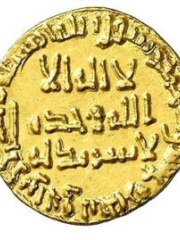
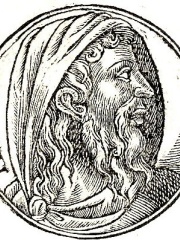
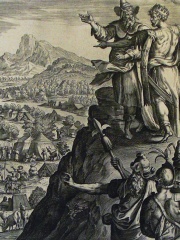
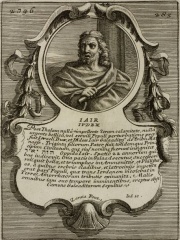
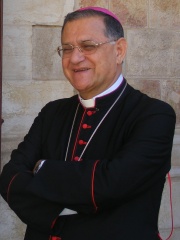
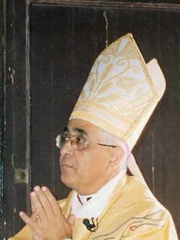
The Most Famous
RELIGIOUS FIGURES from Jordan
This page contains a list of the greatest Jordanian Religious Figures. The pantheon dataset contains 3,187 Religious Figures, 8 of which were born in Jordan. This makes Jordan the birth place of the 44th most number of Religious Figures behind Australia, and Belarus.
Top 8
The following people are considered by Pantheon to be the most legendary Jordanian Religious Figures of all time. This list of famous Jordanian Religious Figures is sorted by HPI (Historical Popularity Index), a metric that aggregates information on a biography's online popularity.

1. Aaron (1396 BC - 1274 BC)
With an HPI of 88.47, Aaron is the most famous Jordanian Religious Figure. His biography has been translated into 86 different languages on wikipedia.
According to the Old Testament of the Bible, Aaron ( AIR-ən or ARR-ən) was an Israelite prophet, high priest, and the elder brother of Moses. Information about Aaron comes exclusively from religious texts, such as the Hebrew Bible, the New Testament (Luke, Acts, and Hebrews), and the Quran. The Hebrew Bible relates that, unlike Moses, who grew up in the Egyptian royal court, Aaron and his elder sister Miriam remained with their kinsmen in the northeastern region of the Nile Delta. When Moses first confronted the Egyptian king about the enslavement of the Israelites, Aaron served as his brother's spokesman to the Pharaoh. Part of the Law given to Moses at Sinai granted Aaron the priesthood for himself and his male descendants, and he became the first High Priest of the Israelites. Levitical priests or kohanim are traditionally believed and halakhically required to be of direct patrilineal descent from Aaron. According to the Book of Numbers, Aaron died at 123 years of age, on Mount Hor, in the fortieth year after the Israelites had come out of the land of Egypt. Deuteronomy, however, places these events at Moseroth. Thomas Römer argues the Pentateuch reflects unresolved tensions between Moses, Aaron, and the Levites, with Moses portrayed as dominant.

2. Al-Mansur (714 - 775)
With an HPI of 74.78, Al-Mansur is the 2nd most famous Jordanian Religious Figure. His biography has been translated into 49 different languages.
Abū Jaʿfar ʿAbd Allāh ibn Muḥammad al-Manṣūr (; Arabic: أبو جعفر عبد الله بن محمد المنصور; 714 – 6 October 775) usually known simply as by his laqab al-Manṣūr (المنصور) was the second Abbasid caliph, reigning from 754 to 775 succeeding his brother al-Saffah (r. 750–754). He is known for founding the 'Round City' of Madinat al-Salam, which was to become the core of imperial Baghdad. Modern historians regard al-Mansur as the real founder of the Abbasid Caliphate, one of the largest polities in world history, for his role in stabilizing and institutionalizing the dynasty.

3. Jephthah (1118 BC - 1080 BC)
With an HPI of 72.37, Jephthah is the 3rd most famous Jordanian Religious Figure. His biography has been translated into 31 different languages.
Jephthah (pronounced ; Hebrew: יִפְתָּח, Yiftāḥ) appears in the Book of Judges as a judge who presided over Israel for a period of six years (Judges 12:7). According to Judges, he lived in Gilead. His father's name is also given as Gilead, and, as his mother is described as a prostitute, this may indicate that his father might have been any of the men of that area. Jephthah led the Israelites in battle against Ammon and, in exchange for defeating the Ammonites, made a vow to sacrifice whatever would come out of the door of his house first. When his daughter was the first to come out of the house, he immediately regretted the vow, which bound him to sacrifice his daughter to God. Jephthah carried out his vow. Traditionally, Jephthah ranks among the major judges because of the length of the biblical narrative referring to him, but his story also shares features with those of the minor judges, such as his short tenure—only six years—in office.

4. Balak (b. 0)
With an HPI of 64.48, Balak is the 4th most famous Jordanian Religious Figure. His biography has been translated into 25 different languages.
Balak (Hebrew: בָּלָק Bālāq) was a king of Moab described in the Book of Numbers in the Hebrew Bible, where his dealings with the prophet and Midianite sorcerer Balaam are recounted. Balak tried to engage Balaam for the purpose of cursing the migrating Israelites. The story of Balak is detailed in Numbers 22–24, Judges 11:25, and Micah 6:5. According to Numbers 22:2, and Joshua 24:9, Balak was the son of Zippor. In the chapter of Numbers preceding the introduction of Balak, the Israelites, seeking the Promised Land following their Exodus from Egypt, had defeated the Canaanites at a place named Hormah, as well as the Amorites and the people of Bashan, and next approached Moab. The biblical narrative stresses the fears of the people of Moab, who were 'exceedingly afraid' and 'sick with dread' (NKJV) or 'terrified' (GNT). Their fears appear to relate to the size of the Israelite population and the consequent resource depletion which could be expected if they were permitted to occupy Moabite land. Balak initially conferred with his Midianite allies in order to block Israelite settlement, before sending his elders (and Midianite elders) to seek Balaam's curse on them. Balak sent messengers to Balaam to ask him to come curse the Israelites for them. But, when Balaam consulted God, God told him he musn't go for the people of Israel are a blessed people. Balak again sent messengers more distinguished and more numerous this time with promises of even more gold and silver then before. God tells Balaam he can go but to only do as He commands. As Balaam sets out to Moab God is angry and sends an angel to block his way. On his journey to meet the princes of Moab, the angel of the Lord blocks Balaam's path three times causing his donkey to veer off the path. The angel was visible to the donkey but not to Balaam. Each time the donkey moved to avoid the angel with sword drawn Balaam would beat her. After the third time the Lord opened the mouth of the donkey to speak asking why do you beat me? Then God opened Balaam's eyes so that he could see the angel with his sword drawn standing before him. He tells the angel he will return home: "I have sinned, for I did not know that you stood against me on the road". The angel instructs Balaam to attend the meeting with the princes of Moab but to "say only what I tell you". After his mission with Balaam to curse Israelites failed, Balak decided to ally with Midianites to gather their women in order to lead Israelites men astray in adultery. According to the Pulpit Commentary, Balak seems to be mentioned by name on a papyrus in the British Museum; Gardiner and Caminos, however, transcribe and translate this name as Baꜥalry. In 2019, Israel Finkelstein, Nadav Na'aman and Thomas Römer proposed the common reading of "House of David" in the Mesha Stele is actually "Balak".
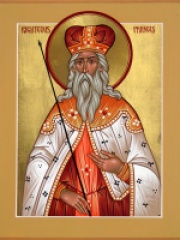
5. Phinehas (b. 1300 BC)
With an HPI of 64.45, Phinehas is the 5th most famous Jordanian Religious Figure. His biography has been translated into 23 different languages.
According to the Hebrew Bible, Phinehas (also spelled Phineas, ; Hebrew: פִּינְחָס, romanized: Pinəḥās, Ancient Greek: Φινεές Phinees, Latin: Phinees) was a priest during the Exodus. The grandson of Aaron and son of Eleazar, the High Priests (Exodus 6:25), he distinguished himself as a youth at Shittim with his zeal against the heresy of Peor. Displeased with the immorality with which the Moabites and Midianites had successfully tempted the Israelites (Numbers 25:1–9) to inter-marry and to worship Baal-peor, Phinehas personally executed an Israelite man and a Midianite woman while they were together in the man's tent, running a javelin or spear through the man and the belly of the woman, bringing to an end the plague sent by Yahweh to punish the Israelites for sexually intermingling with the Midianites. Phinehas is commended by Yahweh in Numbers 25:10–13, as well as King David in Psalm 106 (Psalms 106:28–31) for having stopped Israel's fall into idolatrous practices brought in by Midianite women, as well as for stopping the desecration of Yahweh's sanctuary. After the entry to the land of Israel and the death of his father, he was appointed the third High Priest of Israel, and served at the sanctuary of Bethel (Judges 20:28).

6. Jair (b. 1000 BC)
With an HPI of 62.26, Jair is the 6th most famous Jordanian Religious Figure. His biography has been translated into 24 different languages.
In the Biblical Book of Judges, Jair or Yair (Hebrew: יָאִיר Yā’īr, "he enlightens") was a man from Gilead. He was of the Tribe of Manasseh and also descended from the Tribe of Judah (Numbers 32:39-41, 1 Chronicles 2:21-23). Jair judged Israel for 22 years, after the death of Tola, who had ruled of 23 years. His inheritance was in Gilead through the line of Machir, the son of Manasseh. According to Judges 10:3–5, Jair had thirty sons, who rode thirty ass colts, and controlled 30 cities in Gilead which came to be known as Havoth-Jair (Judges 10:4; cf. 23 towns in 1 Chronicles 2:22). The word chawwoth ('tent encampments') occurs only in this context (Numbers 32:41; Deuteronomy 3:14; Judges 10:4). Jair died and was buried in Kamon, which could be a place that Antiochus III conquered, according to Polybius, but also could be a symbolic term related to the Greek word for 'furnace'. After his death there were 18 years of infidelity to the God of the Israelites and oppression at the hands of their Philistine and Ammonite neighbours. King David appointed a Jairite named Ira as his chief ruler or priest after Sheba's rebellion.

7. Fouad Twal (b. 1940)
With an HPI of 62.05, Fouad Twal is the 7th most famous Jordanian Religious Figure. His biography has been translated into 23 different languages.
Fouad Twal (Arabic: البطريرك فؤاد طوال; born 23 October 1940 in Madaba, Jordan) is a Jordanian Catholic prelate who served as Latin Patriarch of Jerusalem from 2008 to 2016. He has also served as the Grand Prior of the Equestrian Order of the Holy Sepulchre of Jerusalem and President for the Assembly of Catholic Ordinaries of the Holy Land.

8. Maroun Elias Nimeh Lahham (b. 1948)
With an HPI of 55.87, Maroun Elias Nimeh Lahham is the 8th most famous Jordanian Religious Figure. His biography has been translated into 16 different languages.
Maroun Elias Nimeh Lahham (Arabic: مارون إلياس نعمة لحام; born 20 July 1948, Irbid, Jordan) is a Jordanian Catholic prelate who served as the first Bishop of Tunis from 2005 to 2010, and the first Archbishop of Tunis from 2010 to 2012. He later served as the Patriarchal Vicar to Jordan of the Latin Patriarchate of Jerusalem from 2012 until his retirement in 2017.
People
Pantheon has 8 people classified as Jordanian religious figures born between 1396 BC and 1948. Of these 8, 2 (25.00%) of them are still alive today. The most famous living Jordanian religious figures include Fouad Twal, and Maroun Elias Nimeh Lahham. The most famous deceased Jordanian religious figures include Aaron, Al-Mansur, and Jephthah.

